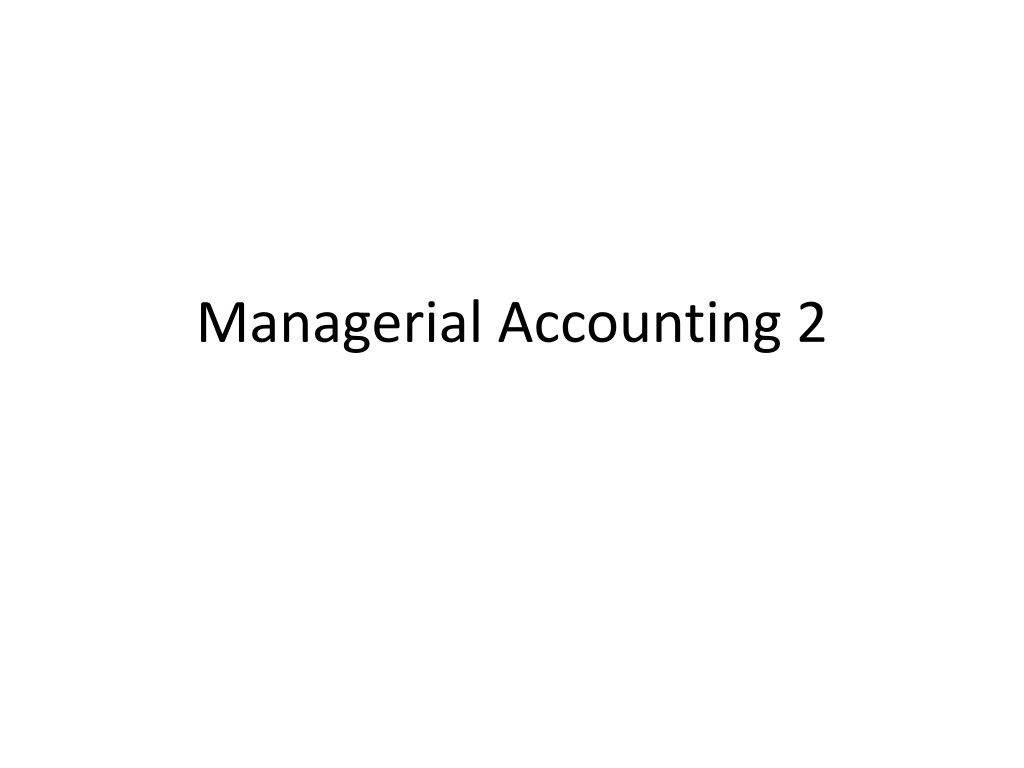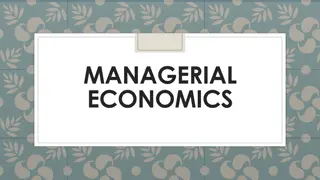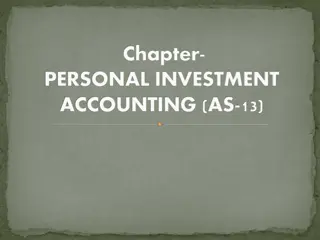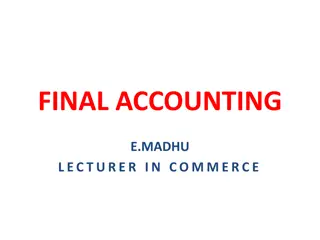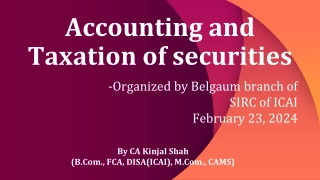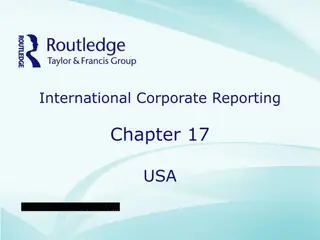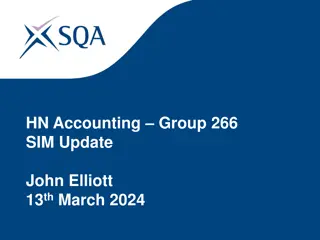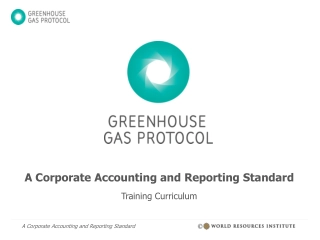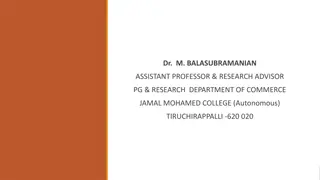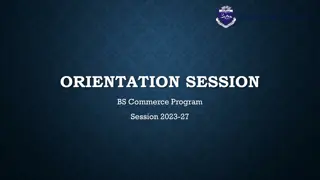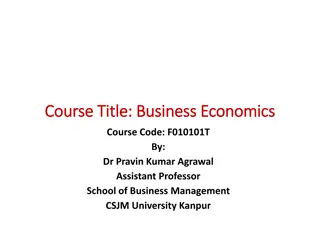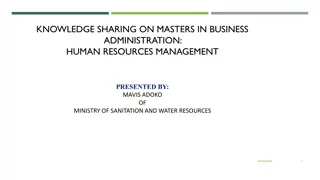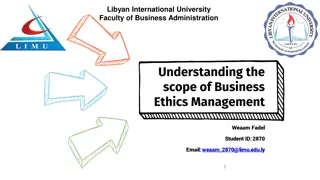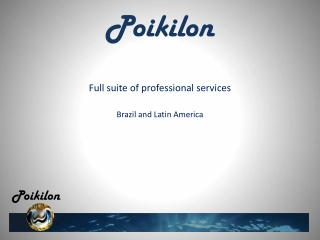Managerial Accounting 2
This chapter explores the fundamental concepts and principles of cost and managerial accounting, emphasizing the importance of understanding and controlling costs for organizational success. It discusses the various classes of manufacturing costs, distinctions between direct and indirect costs, and the interpretation of unit costs. Additionally, the chapter delves into different cost computations for decision-making and the preparation of financial statements for manufacturers, highlighting the essential role of managerial accounting in business operations.
Download Presentation
Please find below an Image/Link to download the presentation.
The content on the website is provided AS IS for your information and personal use only. It may not be sold, licensed, or shared on other websites without obtaining consent from the author. Download presentation by click this link. If you encounter any issues during the download, it is possible that the publisher has removed the file from their server.
Presentation Transcript
CH: 1 Terms, Concepts And Principles Of Cost And Managerial Accounting And Their Purposes
Introduction: This chapter focuses on issues illustrated in the following Feature Story about Al Forat and its parent Company Al Iraq. To succeed, the company needs to determine and control the costs of material, labor, and overhead, and understand the relationship between costs and profits. Managers often make decisions that determine their company s fate and their own. Managers are evaluated on the results of their decisions. Managerial accounting provides tools to assist management in making decisions and to evaluate the effectiveness of those decision
LEARNING OBJECTIVES AFTER STUDYING THIS CHAPTER 1. Identify The Features Of Managerial Accounting And The Functions Of Management. (Comparing Managerial And Financial Accounting, Management Functions, Organizational Structure). 2. Describe The Classes Of Manufacturing Costs And The Differences Between Product And Period Costs. (Manufacturing Costs, Product Vs. Period Costs, Exhibit Of Cost Concepts). 3. Define And Illustrate A Cost Object. 4. Distinguish Between Direct Costs And Indirect Costs. 5. Explain Variable Costs And Fixed Costs.
6. Understand Why Unit Costs Must Be Interpreted With Caution. 7. Distinguish Between Service Sector, Merchandising- Sector And Manufacturing- Sector Companies. 8. Differentiate Between Capitalized Costs And Period Costs. 9. Explain How Different Ways Of Computing Product Costs Are Appropriate For Different Purposes. 10. Explain Why In The Short Term Some Costs And Revenues Are Not Relevant For Decision-Making. 11. Demonstrate How To Compute Cost Of Goods Manufactured And Prepare Financial Statements For A Manufacturer. (Cost Of Goods Manufactured, Cost Of Goods Sold Schedule, Income Statement, Balance Sheet).
1. Identify The Features Of Managerial Accounting And The Functions Of Management. (Comparing Managerial And Financial Accounting, Management Functions, Organizational Structure).
Managerial Accounting Basic. Managerial Accounting provides economic and financial information for managers and other internal users. The skills that you learn in this course will be vital to your future success in business. You don t believe us? Let s look at some examples of some of the crucial activities of employees at AL FORAT and where those activities are addressed in this textbook
In order to know whether it is making a profit, AL FORAT needs accurate information about the cost of each kayak. To be profitable, Current Designs adjusts the number of kayaks it produces in response to changes in economic conditions and consumer tastes. It needs to understand how changes in the number of kayaks it produces impact its production costs and profitability. Further, AL FORAT managers often consider alternative courses of action. For example, should the company accept a special order from a customer, produce a particular kayak component internally or outsource it, or continue or discontinue a particular product line ? Finally, one of the most important and most difficult decisions is what price to charge for the kayaks
In order to plan for the future, AL FORAT prepares budgets, and it then compares its budgeted numbers with its actual results to evaluate performance and identify areas that need to change. Finally, it sometimes needs to make substantial investment decisions, such as the building of a new plant or the purchase of new equipment
Someday, you are going to face decisions just like these. You may end up in sales, marketing, management, production, or finance. You may work for a company that provides medical care, produces software, or serves up mouth-watering meals. No matter what your position is and no matter what your product, the skills you acquire in this class will increase your chances of business success. Put another way, in business you can either guess or you can make an informed decision. As a CEO of Microsoft once noted:
If youre supposed to be making money in business and supposed to be satisfying customers and building market share, there are numbers that characterize those things. And if somebody can t speak to me quantitatively about it, then I m nervous. This course gives you the skills you need to quantify information so you can make informed business decisions.
Comparing Managerial and Financial Accounting There are both similarities and differences between managerial and financial accounting. First, each field of accounting deals with the economic events of a business. For example, determining the unit cost of manufacturing a product is part of managerial accounting. Reporting the total cost of goods manufactured and sold is part of financial accounting. In addition, both managerial and financial accounting require that a company s economic events be quantified and communicated to interested parties. Exhibit 1-1 summarizes the principal differences between financial accounting and managerial accounting
Solved Example(1) Indicate whether the following statements are True or False. If false, explain why. 1. Managerial accountants have a single role within an organization: collecting and reporting costs to management. 2. Financial accounting reports are general-purpose and intended for external users. 3. Managerial accounting reports are special- purpose and issued as frequently as needed.
4. Managers activities and responsibilities can be classified into three broad functions: cost accounting, budgeting, and internal control. 5. Managerial accounting reports must now comply with generally accepted accounting principles (GAAP).
Solution 1. False. Managerial accountants do determine product costs, but they are also responsible for evaluating how well the company employs its resources. As a result, when the company makes critical strategic decisions, managerial accountants serve as team members alongside personnel from production, marketing, and engineering.
2. True. 3. True. 4. False. Managers activities are classified into three broad functions: planning, directing, and controlling. Planning requires managers to look ahead to establish objectives. Directing involves coordinating a company s diverse activities and human resources to produce a smooth-running operation. Controlling keeps the company s activities on track. 5. False. Managerial accounting reports are for internal use and thus do not have to comply with GAAP
Example Distinguish Between Managerial And Financial Accounting: Solved Example(2)
Solved Example(3) Listed below are the three functions of the management of an organization. 1 . Planning 2. Directing 3. Controlling Identify which of the following statements best describes each of the above functions. a.________ requires management to look ahead and to establish objectives. A key objective of management is to add value to the business. b._________ involves coordinating the diverse activities and human resources of a company to produce a smooth-running operation. This function relates to the implementation of planned objectives. c. _________is the process of keeping the activities on track. Management determines whether goals are being met and what changes are necessary when there are deviations.
Learning Objective 2 Describe the classes of manufacturing costs and the differences between product and period costs. Managerial Cost Concepts In order for managers at AL FORAT to plan, direct, and control operations effectively, they need good information. One very important type of information relates to costs. Managers should ask questions such as the following.
1. What costs are involved in making a product or performing a service? 2. If we decrease production volume, will costs change? 3. What impact will automation have on total costs? 4. How can we best control costs?
To answer these questions, managers obtain and analyze reliable and relevant cost information. The first step is to understand the various cost categories that companies use Costs, Cost Drivers, Cost Objectives : A critical step in achieving a competitive advantage is to identify the key costs and the drivers of those costs within the company or organization. In P&G s case, product complexity is one of those key cost drivers
A company incurs a Cost when it uses a resource for some purpose. For example, a company producing kitchen appliances incurs the costs of certain resources, the costs of materials (such as sheet metal and bolts for the enclosure), costs of manufacturing labor, and other costs. Often costs are assigned into meaningful groups called Cost Pools. Costs can be grouped in many different ways, including by type of cost (labor costs in one pool, material costs in another),
by source (department 1, department 2), or by responsibility (manager 1, manager 2). For example, an assembly department or a product engineering department might be treated as a cost pool
A Cost Driver is any factor that has the effect of changing the amount of total cost. For a firm that competes on the basis of cost leadership, management of the key cost drivers is essential. For example, to achieve its low-cost leadership in manufacturing, P&G carefully watches the design and manufacturing factors that drive the costs of its products. It makes design improvements when necessary, and the manufacturing plants are designed and automated for the highest production efficiency.
For firms that are not cost leaders, the management of cost drivers may not be so critical, but attention to the key cost drivers contributes directly to the firm s success. For example, because an important cost driver for retailers is loss and damage to merchandise, most retailers establish careful procedures for handling, displaying, and storing their merchandise.
A Cost Objective is any product, service, customer, activity, or organizational unit to which costs are assigned. Products, services, and customers are generally cost objects; manufacturing departments are considered either cost pools or cost objects, depending on whether management s main focus is on the costs for the products or the costs for the manufacturing departments. The concept of cost objects is a broad concept. It includes products, groups of products (called Value Streams), services, projects, and departments; it can also apply to customers or vendors, among many other possibilities. Cost objects play a key role in decision making, performance measurement, and strategy implementation, as well as financial statement preparation and tax preparation
Manufacturing Costs Manufacturing consists of activities and processes that convert raw materials into finished goods. Contrast this type of operation with merchandising, which sells products in the form in which they are purchased. Manufacturing costs incurred to produce a product are classified as direct materials, direct labor, and manufacturing overhead
Direct Materials To obtain the materials that will be converted into the finished product, the manufacturer purchases raw materials. Raw materials are the basic materials and parts used in the manufacturing process
Raw materials that can be physically and directly associated with the finished product during the manufacturing process are Direct Materials. Examples include flour in the baking of bread, syrup in the bottling of soft drinks, and steel in the making of automobiles. A primary direct material of many AL FORAT kayaks is polyethylene powder. Some of its high- performance kayaks use Kevlar.
Some raw materials cannot be easily associated with the finished product. These are called indirect materials. Indirect Materials have one of two characteristics. (1) They do not physically become part of the finished product (such as polishing compounds used by ALFORAT for the finishing touches on kayaks). Or, (2) they are impractical to trace to the finished product because their physical association with the finished product is too small in terms of cost (such as cotter pins and lock washers used in kayak rudder assembly). Companies account for indirect materials as part of Manufacturing Overhead
Direct Labor The work of factory employees that can be physically and directly associated with converting raw materials into finished goods is direct labor. Bottlers at Coca-Cola, bakers at Sara Lee, and equipment operators at ALFORAT are employees whose activities are usually classified as direct labor. Indirect labor refers to the work of employees that has no physical association with the finished product or for which it is impractical to trace costs to the goods produced. Examples include wages of factory maintenance people, factory time-keepers, and factory supervisors. Like indirect materials, companies classify indirect labor as Manufacturing Overhead.
Example Labor Cost, Overtime, And Idle Time:- Solved Example(4) David Letterman works in the production department of Northeast Plastics (NEP) as a machine operator. David, a long-time employee of NEP, is paid on an hourly basis at a rate of $24 per hour. David works five 8-hour shifts per week Monday Friday (40 hours). Any time David works over and above these 40 hours is considered overtime for which he is paid at a rate of time and a half ($36 per hour). If the overtime falls on weekends, David is paid at a rate of double time ($48 per hour). David is also paid an additional $24 per hour for any holidays worked, even if it is part of his regular 40 hours. David is paid his regular wages even if the machines are down (not operating) due to regular machine maintenance, slow order periods, or unexpected mechanical problems. These hours are considered "idle time".
During December David worked the following hours: Hours Worked Including Machine Downtime Machine Downtime week1 50 6.0 week2 44 2.0 week3 46 4.0 week4 45 3.5
Included in the total hours worked are two company holidays (Christmas Eve and Christmas Day) during Week 4. All overtime worked by David was Monday Friday, except for the hours worked in Week 3; all of the Week 3 overtime hours were worked on a Saturday. Required: 1. Calculate (a) direct manufacturing labor, (b) idle time, (c) overtime and holiday premium, and (d) total earnings for David in December. 2. Is idle time and overtime premium a direct or indirect cost of the products that David worked on in December? Explain.
Manufacturing Overhead Manufacturing overhead consists of costs that are indirectly associated with the manufacture of the finished product (see Alternative Terminology- Some companies use terms such as factory overhead, indirect manufacturing costs, and burden instead of manufacturing overhead.). Overhead costs also include manufacturing costs that cannot be classified as direct materials or direct labor. Manufacturing overhead includes indirect materials, indirect labor, depreciation on factory buildings and machines, and insurance, taxes, and maintenance on factory facilities
One study of manufactured goods found the following magnitudes of the three different product costs as a percentage of the total product cost: direct materials 54%, direct labor 13%, and manufacturing overhead 33%. Note that the direct labor component is the smallest. This component of product cost is dropping substantially because of automation. Companies are working hard to increase productivity by decreasing labor. In some companies, direct labor has become as little as 5% of the total cost.
Product Versus Period Costs Each of the manufacturing cost components direct materials, direct labor, and manufacturing overhead are product costs. As the term suggests, Product Costs are costs that are a necessary and integral part of producing the finished product (Alternative Terminology- Product costs are also called inventoriable costs.). Companies record product costs, when incurred, as an asset called inventory. These costs do not become expenses until the company sells the finished goods inventory. At that point, the company records the expense as cost of goods sold.
Period costs are costs that are matched with the revenue of a specific time period rather than included as part of the cost of a salable product. These are nonmanufacturing costs. Period costs include selling and administrative expenses. In order to determine net income, companies deduct these costs from revenues in the period in which they are incurred. Exhibit 1.3 summarizes these relationships and cost terms. Our main concern in this chapter is with product costs.
Period costs are all costs in the income statement other than cost of goods sold. Period costs, such as design costs, marketing, distribution, and customer service costs, are treated as expenses of the accounting period in which they are incurred because managers expect these costs to increase revenues in only that period and not in future periods. For manufacturing sector companies,
all nonmanufacturing costs in the income statement are period costs. For merchandising-sector companies, all costs in the income statement not related to the cost of goods purchased for resale are period costs. Examples of these period costs are labor costs of sales-floor personnel and advertising costs. Because there are no inventoriable costs for service sector companies, all costs in the income statement are period costs.
Example : Here are some of the costs that your snowboard factory, Terrian Park Boards, would incur. .Terrain Park Boards 1. The materials cost of each snowboard (wood cores, fiberglass, resins, metal screw holes, metal edges, and ink) is $30. 2. The labor costs (for example, to trim and shape each board using jig saws and band saws) are $40. 3. Depreciation on the factory building and equipment (for example, presses, grinding machines, and lacquer machines) used to make the snowboards is $25,000 per year. 4. Property taxes on the factory building (where the snowboards are made) are $6,000 per year
5. Advertising costs (mostly online and catalogue) are $60,000 per year. 6. Sales commissions related to snowboard sales are $20 per snowboard. 7. Salaries for factory maintenance employees are $45,000 per year. 8. The salary of the plant manager is $70,000. 9. The cost of shipping is $8 per snowboard
Example Managerial Cost Concepts: :Solved Example(6) A bicycle company has these costs: tires, salaries of employees who put tires on the wheels, factory building depreciation, advertising expenditures, factory machine lubricants, spokes, salary of factory manager, salary of accountant, handlebars, and salaries of factory maintenance employees. Required : Classify each cost as direct materials, direct labor, overhead, or a period cost. Solution
Solution: Direct materials: Tires, spokes, and handlebars. Direct labor: Salaries of employees who put tires on the wheels. Manufacturing overhead: Factory building depreciation, factory machine lubricants, salary of factory manager, and salaries of factory maintenance employees. Period costs: Advertising expenditures and salary of accountant
Example Classify Manufacturing Costs: Solved Example(7) Determine whether each of the following costs should be classified as direct materials (DM), direct labor (DL), or manufacturing overhead (MO). a. ________Frames and tires used in manufacturing bicycles. b. ________Wages paid to production workers. c. ________Insurance on factory equipment and machinery. d. ________Depreciation on factory equipment
Solution (a) DM Frames and tires used in manufacturing bicycles. (b) DL Wages paid to production workers. (c) MO Insurance on factory equipment and machinery. (d) MO Depreciation on factory equipment
Example Classify manufacturing costs : Solved Example(8) Indicate whether each of the following costs of an automobile manufacturer would be classified as direct materials, direct labor, or manufacturing overhead. a. ________Windshield. e. ________Factory machinery lubricants. b. ________Engine. f. ________Tires. c. ________Wages of assembly line worker. g. ________Steering wheel. d. ________Depreciation of factory machinery. h. ________Salary of painting supervisor.
Solution (a) Direct materials. (b) Direct materials. (c) Direct labor. (d) Manufacturing overhead. (e) Manufacturing overhead. (f) Direct materials. (g) Direct materials. (h) Manufacturing overhead
Example Identify product and period costs Solved Example(9) Identify whether each of the following costs should be classified as product costs or period costs. a. ________Manufacturing overhead. b. ________Selling expenses. c. ________Administrative expenses. d. ________Advertising expenses. e. ________Direct labor. f. ________Direct materials.
